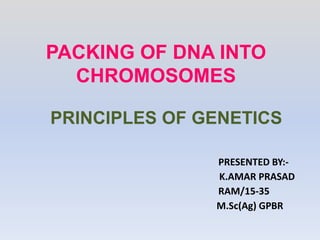
Amar genetics
- 1. PACKING OF DNA INTO CHROMOSOMES PRINCIPLES OF GENETICS PRESENTED BY:- K.AMAR PRASAD RAM/15-35 M.Sc(Ag) GPBR
- 2. Relative position of chromosome in cell
- 3. Chemical composition of Eukaryotic chromosome • Chemically chromosomes are nucleoprotein in nature means are composed of RNA, DNA and protein. • Generally chromosomes contains 30-40% DNA, 50-65% protein and 0.5-10% RNA 1) DNA- The amount of DNA present in somatic cell is constant. DNA content of gametic cell is half of that of somatic cell. DNA of chromosome is of two types i) Unique DNA ii) Repetitive DNA i) Unique DNA- unique DNA consists of those DNA sequence which are present in a single copy per genome and are unique in nature
- 4. • Unique DNA is also known as non repetitive DNA. Codes for protein which requires in large quantity for cell. eg- storage protein ii) Repetitive DNA- Repetitive DNA consists of DNA nucleotides or base sequences, which are few to several hundred base pairs (bp) long and are present to several to a million copies per genome. Human genome contains 30% repetitive DNA. Repetitive DNA is further divided into i) Highly repetitive DNA and ii) Moderately repetitive DNA 2) RNA- Purified chromatin contain 10-15% RNA. RNA associated with chromosome is messenger RNA, transfer RNA and ribosomal RNA.
- 5. 3) Protein- Protein associated with chromosome is classified into two broad groups i) Histone or basic protein ii) Non histone protein Non histone proteins are acidic in nature and histone proteins are basic in nature because of basic amino acids. i) Histone protein- histones constitutes about 80% of the total chromosomal protein. They are present in an almost 1:1 ratio with DNA. Five fractions of histones are present like 1H1, 2H2a, 2H2b, 2H3 and 2H4 ii) ii) Non histone protein- non histone proteins make up to 20% of the total protein mass. Content of non histone protein is different from species to species. Non histone protein includes many important enzymes like DNA and RNA polymerase.
- 7. • Eukaryotic species contain one or more sets of chromosomes – Each set is composed of several different linear chromosomes • The total amount of DNA in eukaryotic species is typically greater than that in bacterial cells • Chromosomes in eukaryotes are located in the nucleus – To fit in there, they must be highly compacted • This is accomplished by the binding of many proteins • The DNA-protein complex is termed chromatin EUKARYOTIC CHROMOSOMES
- 8. • A eukaryotic chromosome contains a long, linear DNA molecule • Three types of DNA sequences are required for chromosomal replication and segregation – Origins of replication – Centromeres – Telomeres Organization of Eukaryotic Chromosomes
- 10. DNA to chromosomes ????????????
- 12. The compaction of linear DNA in eukaryotic chromosomes involves interactions between DNA and various proteins Proteins bound to DNA are subject to change during the life of the cell These changes affect the degree of chromatin compaction Eukaryotic Chromatin Compaction NUCLEOSOME SOLENOID MODEL
- 13. The repeating structural unit within eukaryotic chromatin is the nucleosome It is composed of double-stranded DNA wrapped around an octamer of histone proteins An octamer is composed two copies each of four different histones 146 bp of DNA make 1.65 negative superhelical turns around the octamer Overall structure of connected nucleosomes resembles “beads on a string” This structure shortens the DNA length about seven-fold. NUCLEOSOMES
- 14. Vary in length between 20 to 100 bp, depending on species and cell type Diameter of the nucleosome
- 15. Histone proteins are basic They contain many positively-charged amino acids Lysine and arginine These bind with the phosphates along the DNA backbone There are five types of histones H2A, H2B, H3 and H4 are the core histones, Two of each make up the octamer H1 is the linker histone Binds to linker DNA, Also binds to nucleosomes But not as tightly as are the core histones
- 18. Play a role in the organization and compaction of the chromosome
- 19. Nucleosomes associate with each other to form a more compact zig-zag structure fiber of 30 nm. This was reveled by F.Thoma. Histone H1 plays a role in this compaction At moderate salt concentrations, H1 is removed The result is the classic beads-on-a-string morphology At low salt concentrations, H1 remains bound Beads associate together into a more compact morphology Nucleosomes Join to Form a 30 nm Fiber
- 20. The 30 nm fiber shortens the total length of DNA another seven-fold Its structure of 30 nm fiber has proven difficult to determine The DNA conformation may be substantially altered when extracted from living cells Two models have been proposed Solenoid model Three-dimensional zigzag model
- 21. Regular, spiral configuration containing six nucleosomes per turn Irregular configuration where nucleosomes have little face-to-face contact
- 22. So far the DNA have been shortened the about 50-fold A third level of compaction involves interaction between the 30 nm fiber and the nuclear matrix The nuclear matrix is composed of two parts Nuclear lamina Internal matrix proteins 10 nm fiber and associated proteins Further Compaction of the Chromosome
- 23. SCHEMATIC FIGURE SHOWS THE ARRANGEMENT OF THE MATRIX WITHIN THE CELL
- 24. The third mechanism of DNA compaction involves the formation of radial loop domains Matrix-attachment regions Scaffold-attachment regions (SARs) or MARs are anchored to the nuclear matrix, thus creating radial loops 25,000 to 200,000 bp
- 25. The attachment of radial loops to the nuclear matrix is important in two ways 1. It plays a role in gene regulation 2. It serves to organize the chromosomes within the nucleus Each chromosome in the nucleus is located in a discrete and nonoverlapping chromosome territory Further Compaction of the Chromosome